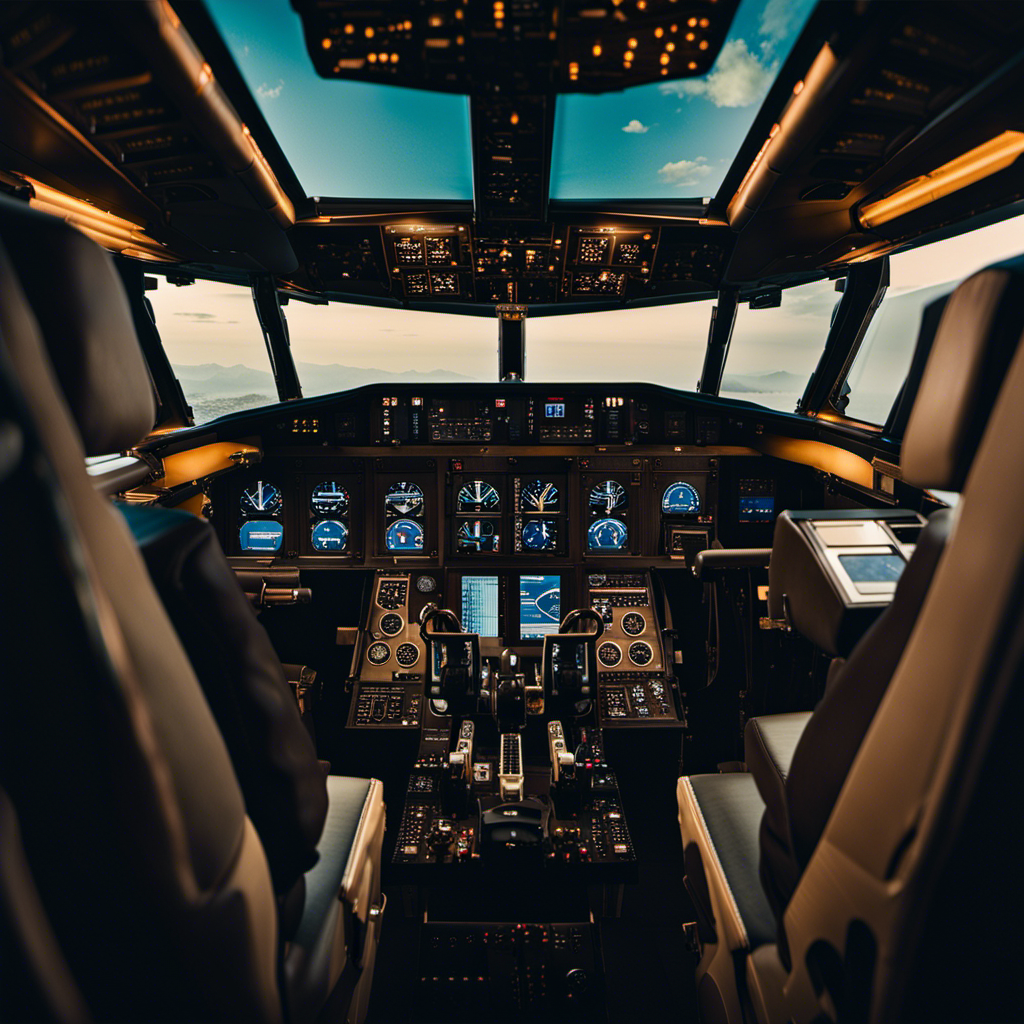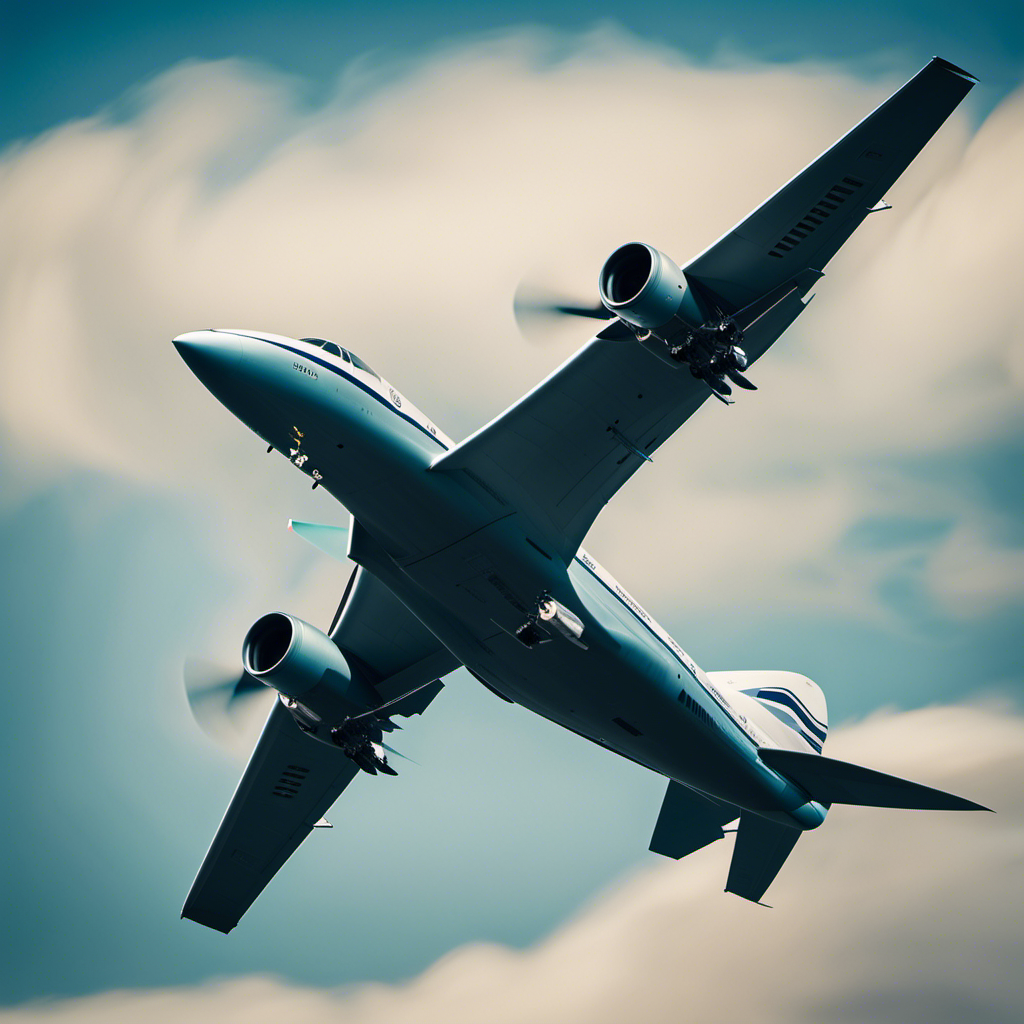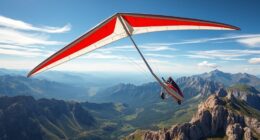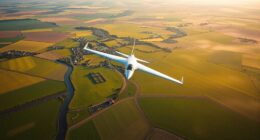Have you ever considered how fast a glider plane can fly?
Prepare to be amazed as we delve into the world of glider planes and uncover the secrets behind their average speed. From the moment these engineless aircraft take flight, they defy gravity with grace and precision.
In this article, we will explore the factors that influence the average speed of glider planes and reveal the typical speed range they can achieve.
Get ready to soar through the skies and discover the true potential of these magnificent flying machines.
Key Takeaways
- The average speed of a glider plane is influenced by factors such as aerodynamic design, soaring techniques, and efficient energy management systems.
- Slower speeds in glider planes offer advantages such as enhanced visibility, longer flight durations, and the ability to explore a wider range of areas.
- Equipment such as GPS navigation, traffic alert systems, and enhanced vision systems can enhance visibility and observation during glider flights.
- Future advancements in glider plane technology, including improved aerodynamic designs, electric propulsion, advanced control systems, and lightweight composite materials, have the potential to increase glider plane speeds and improve performance.
Definition and Overview of Glider Planes
A glider plane is an aircraft that doesn’t have an engine and relies on natural forces, such as gravity and air currents, to stay in flight. Unlike powered aircraft, gliders are designed to be lightweight and have a high lift-to-drag ratio. This allows them to glide through the air with minimal resistance, maximizing their flight time.
The absence of an engine means that gliders cannot generate their own thrust, but they can still achieve flight by utilizing the energy from the surrounding environment. By strategically maneuvering in thermals, which are rising columns of warm air, gliders can gain altitude. Additionally, they can exploit ridge lift, which is created when wind encounters a sloping surface.
These techniques enable glider planes to stay airborne for extended periods, showcasing the remarkable ingenuity of their design.
How Gliders Achieve Flight without an Engine
To achieve flight without an engine, you need to understand how gliders rely on rising air currents. Gliders are aircraft designed to fly without an engine by utilizing the natural movement of air. By taking advantage of air currents, gliders are able to stay aloft and even gain altitude. These air currents, known as thermals, are columns of rising warm air that gliders can ride to gain height. To give you a better idea, here is a visualization of how gliders use thermals:
| Glider | ||
| ——– | ——– | ——– |
| Thermal | ||
| ——– | ——– | ——– |
As the glider moves through the rising air in the thermal, it gains altitude. Once it reaches a certain height, the pilot can then glide to a new area of rising air, repeating the process to maintain flight. This method allows gliders to stay airborne for extended periods of time, making them a popular choice for recreational and competitive flying. Understanding the principles of glider flight without an engine is important in comprehending the factors that affect the average speed of glider planes.
Factors Affecting the Average Speed of Glider Planes
Understanding the factors that impact how fast you can fly in a glider is crucial for maximizing your flight experience. Here are the key factors that affect the average speed of glider planes:
-
Weather conditions: Wind speed and direction play a significant role in determining the speed of your glider. Tailwinds can increase your speed, while headwinds can slow you down.
-
Glider design: The aerodynamic design of the glider, including its wingspan, aspect ratio, and airfoil shape, affects its efficiency and speed through the air.
-
Weight and load: The weight of the glider and the distribution of its load can impact its speed. Lighter gliders tend to be faster, while carrying excessive weight can slow you down.
-
Pilot skill and technique: Your skill as a pilot, including your ability to find and utilize thermals and other sources of lift, can greatly influence your glider’s speed.
By understanding and optimizing these factors, you can achieve the best possible speed in your glider.
Now let’s explore the typical average speed range for glider planes.
Typical Average Speed Range for Glider Planes
When flying a glider, you can expect to reach speeds ranging from 60 to 90 miles per hour. Glider planes are designed to maximize efficiency and minimize drag, allowing for smooth and graceful flight.
The average speed of a glider plane depends on various factors such as wind conditions, pilot skill, and the type of glider being flown. In ideal conditions, experienced pilots can achieve speeds at the higher end of this range. However, it is important to note that gliders are not built for speed but rather for soaring through the air.
These aircraft are designed to harness the natural energy of the atmosphere, utilizing thermals and updrafts to maintain altitude and extend flight time.
Now, let’s explore the world record speeds for glider planes.
World Record Speeds for Glider Planes
If you want to learn about world record speeds for glider planes, you’ll be amazed by the incredible velocities achieved by these aircraft. Gliders, despite lacking engines, are capable of reaching astonishing speeds thanks to their aerodynamic designs and the skill of their pilots. Here are some mind-boggling speed records that have been achieved:
- The highest speed ever recorded by a glider is 504.7 km/h (313.48 mph), achieved by Klaus Ohlmann in 2003.
- The world record for the fastest average speed over a triangular course is 378.2 km/h (235.17 mph), set by Alexander Mueller in 2017.
- The longest distance flown in 24 hours by a glider is 3,008.5 km (1,868.61 miles), accomplished by Klaus Ohlmann in 2003.
- The fastest speed reached by a glider during a wave flight is 296.8 km/h (184.54 mph), accomplished by Klaus Ohlmann in 2009.
- The world record for the fastest speed around a 100 km (62.14 miles) closed course is 363.6 km/h (226.01 mph), set by Klaus Ohlmann in 2012.
These records demonstrate the extraordinary capabilities of glider planes and the incredible speeds that can be achieved through skilled piloting and favorable weather conditions.
Now let’s explore the importance of speed control in glider flying.
Importance of Speed Control in Glider Flying
Now that you understand the incredible speeds that glider planes can reach, it is crucial to delve into the importance of speed control in glider flying.
As a glider pilot, you must have a firm grasp on managing and adjusting your speed to ensure optimal performance and safety during flight. Speed control is essential for maintaining stability, maneuverability, and efficient energy usage in a glider.
By carefully adjusting your airspeed, you can control the glider’s rate of climb or descent, as well as its turning capabilities. Additionally, speed control plays a significant role in preventing stall, which occurs when the wing’s lift is no longer able to support the glider’s weight.
Mastering speed control is a fundamental skill that every glider pilot must possess to navigate the skies safely and effectively.
Transitioning to the next section, let’s now explore the various safety considerations in glider flying.
Safety Considerations in Glider Flying
To ensure your safety while flying a glider, it is essential to understand and adhere to various safety considerations.
First and foremost, always perform a thorough pre-flight inspection, checking for any signs of damage or malfunction.
It is crucial to be familiar with the glider’s emergency procedures and practice them regularly.
Additionally, pay close attention to weather conditions, as sudden changes can pose risks.
Always wear appropriate safety gear, including a helmet and a parachute.
During takeoff and landing, maintain a safe distance from other aircraft and follow proper communication protocols.
Advantages of Flying at Slower Speeds in Glider Planes
When flying at slower speeds in glider planes, you’ll experience enhanced visibility and observation.
This is because the slower pace allows you to have a more detailed view of your surroundings, enabling you to detect potential obstacles or changes in weather conditions more effectively.
Additionally, flying at slower speeds increases your flight duration, allowing you to stay in the air for longer periods of time and explore a wider range of areas.
This can be particularly beneficial when conducting aerial surveys or engaging in recreational flying activities.
Enhanced Visibility and Observation
If you want to improve your visibility and observation while flying a glider plane, consider using enhanced equipment. By utilizing advanced technology and specialized gear, you can enhance your flying experience and stay safe in the air. One way to achieve this is by using a combination of instruments and tools that provide you with valuable information about your surroundings. Here is a table showcasing some of the equipment you can use to enhance your visibility and observation while flying a glider plane:
| Equipment | Purpose |
|---|---|
| GPS Navigation | Provides accurate location and route tracking |
| Traffic Alert System | Alerts you to nearby aircraft |
| Enhanced Vision System | Enhances visibility in low light conditions |
Longer Flight Duration
Now that you understand the importance of enhanced visibility and observation in glider planes, let’s delve into another advantage of these aircraft: longer flight duration.
Glider planes are designed to stay airborne for extended periods, allowing for more time in the air and greater distances covered. Here are three key factors contributing to their impressive flight duration:
-
Aerodynamic design: Gliders are built with sleek, streamlined shapes that minimize drag and maximize efficiency, enabling them to stay aloft for longer periods.
-
Soaring techniques: Glider pilots utilize various techniques, such as ridge soaring and thermal soaring, to exploit rising air currents and gain altitude, effectively extending their flight time.
-
Efficient energy management: Gliders are equipped with advanced energy management systems, including regenerative braking systems and solar panels, which help conserve and generate energy during flight.
With the ability to stay airborne for extended periods, glider planes offer unique opportunities for exploration and adventure.
Now, let’s explore the training and certification requirements for glider pilots.
Training and Certification Requirements for Glider Pilots
To become a certified glider pilot, you’ll need to complete specific training requirements. These requirements ensure that you have the necessary knowledge and skills to safely operate a glider plane.
The training typically consists of ground school instruction and flight training with a certified flight instructor. During ground school, you’ll learn about aerodynamics, weather patterns, navigation, and emergency procedures.
In the flight training portion, you’ll practice takeoffs, landings, maneuvering, and emergency scenarios. Additionally, you’ll need to pass a written exam and a practical flight test to earn your certification.
Once you’ve completed the training and obtained your glider pilot certificate, you’ll be ready to take to the skies and enjoy the exhilarating experience of gliding.
Looking ahead to the future of glider plane technology and speed advancements, there are exciting possibilities on the horizon.
The Future of Glider Plane Technology and Speed Advancements
Advancements in glider technology are expected to revolutionize the flying experience, making it even more thrilling and efficient. Glider planes are known for their ability to soar through the sky with grace and precision, but there is always room for improvement. The future of glider plane technology promises to bring exciting changes that will enhance the speed and performance of these aircraft.
One area of focus is the development of more aerodynamic designs. By reducing drag and increasing lift, glider planes will be able to achieve higher speeds and greater maneuverability. Additionally, advancements in materials and construction techniques will allow for lighter and stronger glider planes, further improving their speed and efficiency.
To give you a glimpse of the potential future of glider plane technology, here is a table showcasing some of the possible advancements:
| Advancement | Description |
|---|---|
| Wingtip devices | Improved wingtip designs that reduce drag and increase lift |
| Electric propulsion | Electric motors that provide additional power for increased speed |
| Advanced control systems | Enhanced flight control systems for improved maneuverability |
| Composite materials | Lightweight and strong materials that improve overall performance |
| Aerodynamic fuselage | Streamlined fuselage designs that minimize drag |
With these advancements, glider planes of the future will be able to reach even higher speeds, providing an exhilarating flying experience for pilots and passengers alike.
Frequently Asked Questions
Are glider planes faster than traditional engine-powered planes?
No, glider planes are not faster than traditional engine-powered planes. Gliders rely solely on wind currents for propulsion, resulting in lower speeds compared to planes with engines that generate their own thrust.
What is the maximum speed that a glider plane can reach?
The maximum speed a glider plane can reach depends on various factors, such as its design, weight, and atmospheric conditions. However, on average, gliders can achieve speeds of around 150 to 200 kilometers per hour.
How is the average speed of a glider plane calculated?
To calculate the average speed of a glider plane, you divide the total distance traveled by the total time taken. This gives you the average speed, which is the rate at which the glider plane covers distance over a given time period.
Can glider planes fly faster with the help of external factors like wind?
Yes, glider planes can fly faster with the help of external factors like wind. The wind creates lift and can push the glider forward, increasing its speed and allowing it to travel faster.
Are there any regulations or restrictions on the maximum speed of glider planes?
Glider planes are subject to regulations and restrictions on their maximum speed to ensure safety. These limits are set to prevent excessive stress on the aircraft and maintain control. Average speed varies depending on factors such as wind conditions.
Conclusion
In conclusion, the average speed of a glider plane can vary depending on various factors such as wind conditions, altitude, and the design of the glider itself.
While the average speed range for glider planes typically falls within a certain range, there have been instances where glider pilots have achieved remarkable speeds, pushing the boundaries of what is possible.
As technology continues to advance, it is exciting to think about the future possibilities for glider plane speed advancements.
So, buckle up and prepare for a thrilling journey into the world of glider planes!









